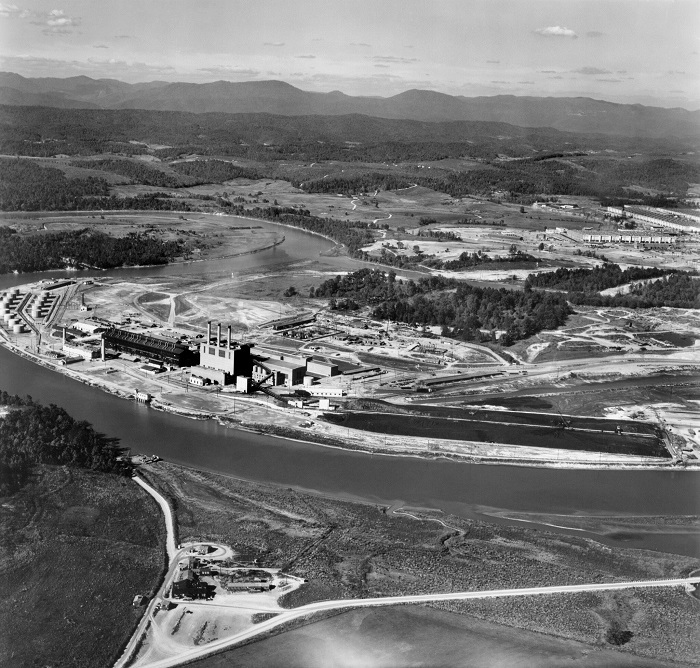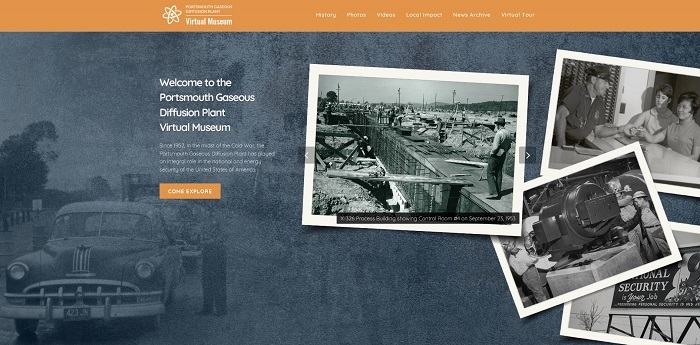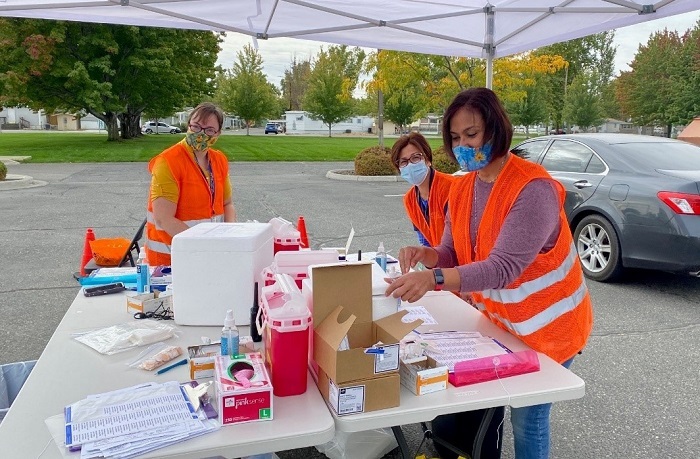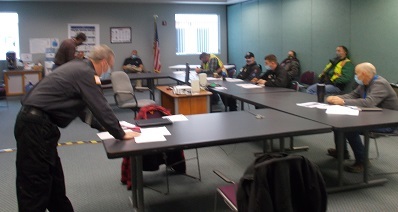 An EM worker relies on a handheld device with GPS technology to ensure precise soil coverage over the various contours of a former oil tank farm site at Oak Ridge.
OAK RIDGE, Tenn. – EM crews at Oak Ridge have laid protective soil over a 9-acre parcel at East Tennessee Technology Park (ETTP) where an oil tank farm once sat, and they’re preparing 21 acres of adjacent land for soil cover to improve site drainage.
The oil tank farm, which operated in the 1940s and 1950s, was used to house fuel for the former K-770 Powerhouse. That facility powered early operations at the former uranium enrichment site.
The tank farm was dismantled in the mid-1950s. Asbestos on the tanks and piping was buried at the site. Years ago workers attempted to remove the buried asbestos but not all of it could be located. The new soil cover is intended to prevent future exposure of any remaining asbestos.
“With core cleanup completed at ETTP, including removal of all unnecessary buildings, the focus at the site is on soil remediation,” said James Daffron, acting ETTP portfolio federal project director. “The protective soil layer over K-770 will reduce site risks as ETTP continues its transformation to a multi-use industrial park, national park, and conservation area.”
 A 1949 photo shows the former K-770 Powerhouse and oil tank farm.
 Crews place soil cover at a former oil tank farm site that once supported the K-770 Powerhouse.
Oak Ridge and its cleanup contractor, UCOR, used innovative GPS technology in the K-770 remediation project to establish proper drainage of the tract while ensuring a 2-foot soil cover.
The precise GPS technology helped workers place soil over the site’s various contours. The system was installed in a handheld device as well as the bulldozer used in the project. The system maps out contours and informs the operator of how much soil is needed to achieve desired contours. This practice allows for appropriate drainage on the site.
“This technology allowed UCOR to use less dirt because it provided essential information that allowed appropriate mapping and coverage of the site,” said Ken Whittle, UCOR project manager. “We precisely followed the contours and were able to consistently place the cover at the right depth, saving time and the cost of additional fill dirt.”
Workers then seeded the site to create a grassy field.
UCOR is now removing vegetation from the adjacent 21-acre area, which was once used as a scrapyard. That work prepares the site for soil coverage, which allows for proper drainage. Removal of the scrap was completed in 2007, and workers excavated and removed contaminated soil.
-Contributor: Wayne McKinney
 A revamped website on the history of the Portsmouth Site updates the story of the historic plant’s impact through the years.
PIKE COUNTY, Ohio – EM recently launched a remodeled version of its popular virtual museum website covering the history of the Portsmouth Site.
“The updated website is an incredible, interactive timeline of the Portsmouth Site,” said Jeff Bettinger, EM site lead for the Portsmouth/Paducah Project Office. “Not only can you learn more about the work over the years, but you see how the Department of Energy’s decision to build in southern Ohio impacted the growth of the region from population, to housing, to operations, to current day. It is an amazing story filled with neighbors, friends, and even family from across the generations. The story continues to grow and so does this website as we move forward.”
The website was first launched in 2012 and has attracted more than 46,000 visitors from 134 countries around the world. The site currently has information, pictures, and videos from 22 different buildings, including some that have already been demolished as part of ongoing decontamination and decommissioning.
Other features include a virtual tour, oral histories from retirees and community members, photos dating back to plant construction, old films and local TV news coverage, and even an employee newsletter archive dating back to the early 1950s. The newly enhanced virtual museum is also now viewable on all mobile devices.
-Contributor: Jack Williams
 Nurses prepare flu vaccines and rosters at a Hanford Site drive-up flu clinic.
RICHLAND, Wash. – Each year, the Hanford Site occupational medical services contractor provides influenza, or flu, immunizations for contractor and EM employees at more than a dozen clinics in buildings around the 580-square-mile site.
However, this year the COVID-19 pandemic posed significant challenges to those traditional worksite flu clinics organized by HPMC Occupational Medical Services.
Medical staff quickly reimagined how to safely provide flu vaccines within COVID-19 safety protocols as use of large conference rooms, with employees lining up in hallways, was not an option.
Instead, the staff conducted drive-up flu clinics at several centrally-located parking lots, giving 2,085 flu shots from Oct. 13 through Nov. 11. Workers can still get a flu shot in the medical clinics through early spring.
Workers stayed in their vehicles at the drive-up clinics, and medical workers adhered to physical distancing safety limits while administering the vaccines.
“The necessity to change the way things normally operate has been a theme for 2020, and the worksite flu clinics were no exception,” said Bessie Ang, director of HPMC nursing services. “With the teamwork and collaboration of the staff and other Hanford contractors, the campaign was successful in helping to protect the health and well-being of the Hanford workforce.”
HPMC noted several lessons learned from the drive-up flu clinics. Challenges included traffic control and weather. Fall in Eastern Washington means unpredictable temperatures and wind. High winds caused two clinics to close early to keep staff, workers, supplies, and materials safe.
-Contributor: Jill Harvill
WEST VALLEY, N.Y. – EM and its cleanup contractor at the West Valley Demonstration Project (WVDP) conducted a training exercise with local emergency response agencies, held virtually due to the COVID-19 pandemic.
Based on a hypothetical emergency, the exercise tested the skills and response of the local agencies and WVDP’s security force and operational response team. Participants were tested on their ability to minimize the scenario’s potential impact to employees, the public, and the environment. Representatives from Cattaraugus County Sheriff’s Department, Cattaraugus County Special Response Team, and West Valley Volunteer Hose Fire and Rescue took part in the event.
“We understand the importance and benefit of having trained emergency responders working at West Valley,” EM WVDP Safety and Site Programs Team Leader Jennifer Dundas said. “We appreciate their continued commitment to training, and their effort to protect the health and safety of our workers and the public.”
 |
|
Emergency response personnel at the West Valley Demonstration Project participate in an exercise to evaluate their response to a hypothetical emergency incident. |
WVDP personnel helped develop the scenario and supported the exercise as controllers, which included coordinating tasks to make the exercise realistic and test the responders.
“You can never practice enough for emergencies,” said Kevin Murray, the event and emergency management manager for CH2M HILL BWXT West Valley. “We must always be learning, training, and evaluating our performance so that we can effectively handle whatever comes our way.”
Participants described actions they would take to minimize the mock incident’s impact. These discussions provided insight to the controllers and evaluators on whether the exercise’s objectives were being met, and helped them determine if the participants would effectively handle an emergency event. Participants received constructive feedback on areas for improvement.
“Disasters can occur at any time, and a knowledgeable, well-trained emergency response team can significantly improve the outcome of any event,” Murray said.
-Contributor: Joseph Pillittere
|